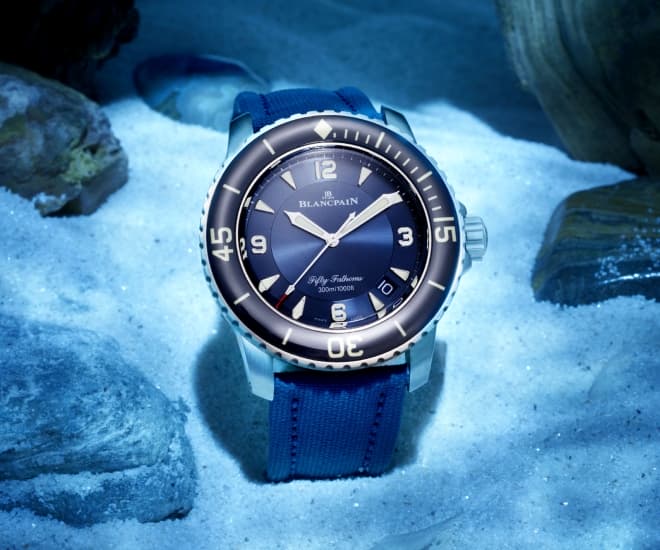
A one-sentence summary will get us started here. In 1953, Swiss watchmaker Blancpain launched the world’s first dive watch; the world of watches would never be the same again. Arguably the most popular type of traditional mechanical wristwatch, the dive watch is a firm favourite amongst collectors and casual buyers alike. Virtually all the major players have one, with the notable exception of haute horlogerie stalwarts Patek Philippe and Vacheron Constantin. Even Audemars Piguet bowed to collector pressure and introduced the Offshore Diver some years back, though that watch is hardly a deeply important part of the assortment. Bucking this trend decisively is Blancpain, which was much more famous for its haute horlogerie pieces for most of its history, as you can see by looking at its collections, but we will get to that in a bit.
Given the peculiar relationship the dive watch has to diving today — basically it is no longer a necessity — this impression only grows more powerful. As a species, we appear to want a symbol of our world’s oceans and seas close to us at all times; we are mostly made of water anyway. If aliens decided to introduce themselves, they might bring us a gift of water from their home world as a greeting! To be clear, this is only an impression as no one really knows about the true appeal of the dive watch, or the reasons brands introduce dive watches, which brings us to another important point.
What evidence do we have to offer on the popularity of dive watches anyway? Is it the biggest seller amongst all watch brands, across the board, Swiss or otherwise? Does this explain why we have devoted at least one cover a year to the dive watch since at least 2016? Unfortunately, none of the reports we consulted for our Spring 2023 issue, from Morgan Stanley and Deloitte’s to the Swiss Federation of Watchmaking (FH) and Europastar, had any data on the abiding popularity of the watch for divers. This is because the watch trade does not do breakdowns in this manner, folding dive watches into three-handlers, at best; some reports discuss the popularity of the sports watch, which obviously includes the dive watch. But, changing the definition this way also tends to draw in other types of hardy tool watches, as well as various complications and all manner of smartwatches.
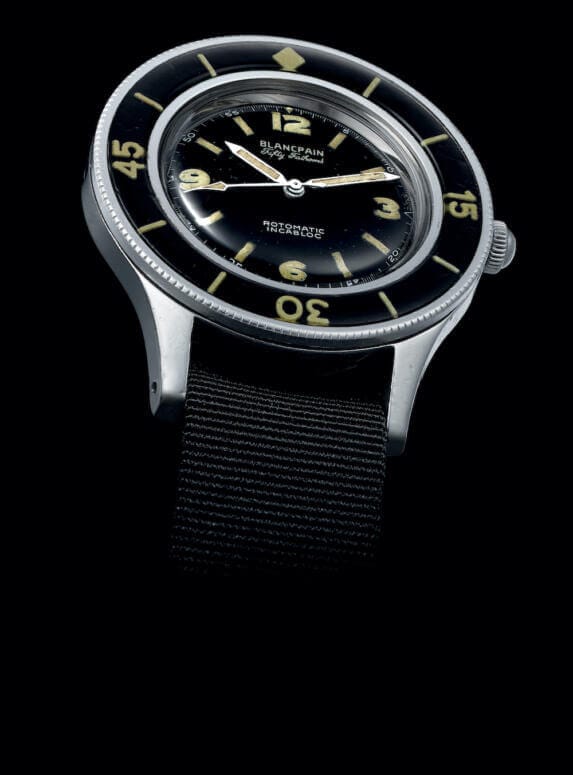
While this is obviously not great for general information, these sorts of watches are the most plentiful in the world, since they also include the toughest tickers. Dive watches might have been the first purpose-built watches for a particular sporting activity, making the Blancpain Fifty Fathoms the first tool watch for sports. Navigation, aviation and driving watches all arrived before the dive watch, but all of these have been eclipsed by the timekeeper of the deep. Even the arrival of cheap quartz watches could not make the sports watch come up for air, so to speak. As for the smartwatch, most models and makes have only recently gotten water-resistance right, thanks to all the detector functions.
Now, if you are a long-time reader of World of Watches, you will probably be sighing to yourself, and wondering just why we are so obsessed with dive watches. Part of the answer lies in the story of the Blancpain Fifty Fathoms, and that leads us directly into our usual history lesson. As far as other key models go though, we will be addressing those more fully later in this story, and later in the year. The historical section also covers the salient characteristics of the Fifty Fathoms as they stand today, and includes a sidebar on Blancpain’s conservation work.
We note at the outset, for transparency, that we are once again indebted to the excellent work of Jeffrey Kingston, the long-time editor of Lettres du Brassus, the Blancpain magazine, for much of the details that went into this story.
Deep Dive

In many ways, Blancpain is a bit of a surprising superstar in diving. Founded in 1735 in Villeret, Switzerland, the manufacture had been largely focused on complications and beautifully finished watches for most of its storied past. This was reinforced by another part of the DNA of the contemporary Blancpain brand, that of Louis Élisée Piguet, that remains famed to this day for its complicated movements. This stands in direct contrast with watchmakers who got off the blocks in the 20th century, for example, where a certain degree of utilitarianism was to be expected.
Blancpain, which had proven to be resilient to every crisis known to man since the 18th century, was an adaptable firm. It even survived its own founding family’s decision to leave the business, finding a ready buyer for the Blancpain watchmaking concern in the faithful employee, Betty Fiechter, in 1932; the Piguet family’s involvement remained some ways away but that is another story. Indeed, Betty Fiechter’s story is a fascinating one, but for the story of the Fifty Fathoms, things begin properly with her nephew, Jean-Jacques Fiechter. It should be noted though that Jean-Jacques was only able to engage in his diving passion because of the home Betty Fiechter owned on the Riviera. It was a location that would play a central role in the genesis of the Fifty Fathoms watch.
Blancpain Fifty Fathoms Bathyscaphe
While Jean-Jacques Fiechter was focussed on making the best dive watch he could in the original Fifty Fathoms of 1953, he did not want to leave out less hardcore enthusiasts, and women of course. He explained that this was why the Fifty Fathoms Bathyscaphe debuted in 1956 in a diameter as small as 38mm. It maintained all the features of the Fifty Fathoms, but sacrificed a little bit of legibility to gain something in terms of wearability. Introduced with a date window from the start (something the Fifty Fathoms did not get at launch), the Bathyscaphe is today a great showcase of Blancpain’s more complex spirit — meaning watches with traditional complications, as seen in these references opposite with complete calendar and moon phase indicator, and flyback chronograph, respectively.
Jean-Jacques became the CEO of Blancpain in 1950, and he had quite the yen for diving. In those days, recreational diving was not yet the force it is today, with the SCUBA apparatus only having been pioneered by Jacques Yves Cousteau in 1943. It was also a dangerous and unpredictable activity since divers at the time did not have the right equipment, including the right sort of dive watch. Jean-Jacques learned this the hard way on a dive at Villefranche-sur-Mer, France. Some 50 metres below the waves (a somewhat unbelievable depth, but that is what the record shows), he discovered that he had run out of air. Not only did Jean-Jacques not panic, he had the presence of mind to consider timing his emergency ascent, except he did not have a watch to do so of course! He later observed that “passion makes one forget the time,” when looking back on his near-fatal accident.
Happily, Jean-Jacques had another passion besides diving: making watches. He soon set about finding a solution to the problem that almost killed him because he realised that a precise, reliable and tough watch was the key. With the resources of a manufacture at his disposal, Jean-Jacques could develop exactly the sort of watch that was needed. This story is precisely what makes the Fifty Fathoms so special and unique in the development of the dive watch.
With the right inspiration, Jean-Jacques reflected on his accident and realised two things: a diver needed to keep track of time during a dive, and also needed to account for time to decompress before surfacing. In other words, it was not enough to know how much air you had left, you also needed to know how much time you could spend, in total, relying on your SCUBA gear. Jean-Jacques began designing a watch that would do all that was required; he needed a ticker that would keep you ticking, to put it another way. From the start, he knew it would have to be a simple and tough timepiece, because chronographs were not water-resistant at all at this time (for those of you who wonder why this solution did not occur to Jean-Jacques or the esteemed watchmakers at Blancpain).
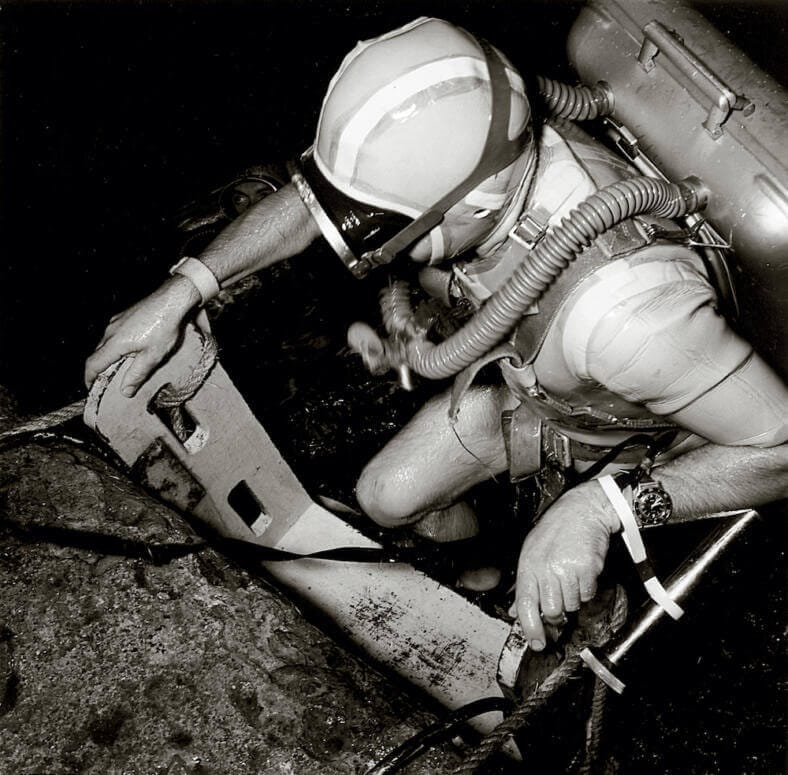
Creating a simple timepiece from scratch is no easy feat, particularly when that timepiece also had to be a lifesaving instrument for divers. Jean-Jacques had to invent what we take for granted today, codified within the strictures of ISO 6425. Take, for example, the issue of water-resistance, which was pretty much resolved by the 1950s…except it was not. There were weak points in any watch, which are the same today, where water might penetrate the case: the crown and the caseback. For the crown, Jean-Jacques came up with the double-sealed system. The crown could be perfectly safe, if it was not pulled out. If one forgets to push or screw the crown back in after adjusting the watch, then jumps off a boat into the water, then that is one watch that just drowned.
Jean-Jacques solution meant that there was always a second seal keeping the worst from happening. Blancpain got a patent for that. For the caseback, there was already an ‘O’ ring gasket keeping the outside, well, outside, but it frequently got twisted when the caseback was screwed on. Jean-Jacques got around this by placing the ‘O’ ring in a channel with its own metal ring to hold it in place. Blancpain got a patent for this too. Finally, to resolve the issue of divers forgetting how long they were underwater, Jean-Jacques developed a turning bezel with a marker that could be used to indicate start times for dives (by aligning the bezel with the minute hand, to be clear). That works well enough, but should the bezel be disturbed, the game is up. Jean-Jacques came up with a locking mechanism that kept the bezel from moving. Blancpain got a patent for that too.
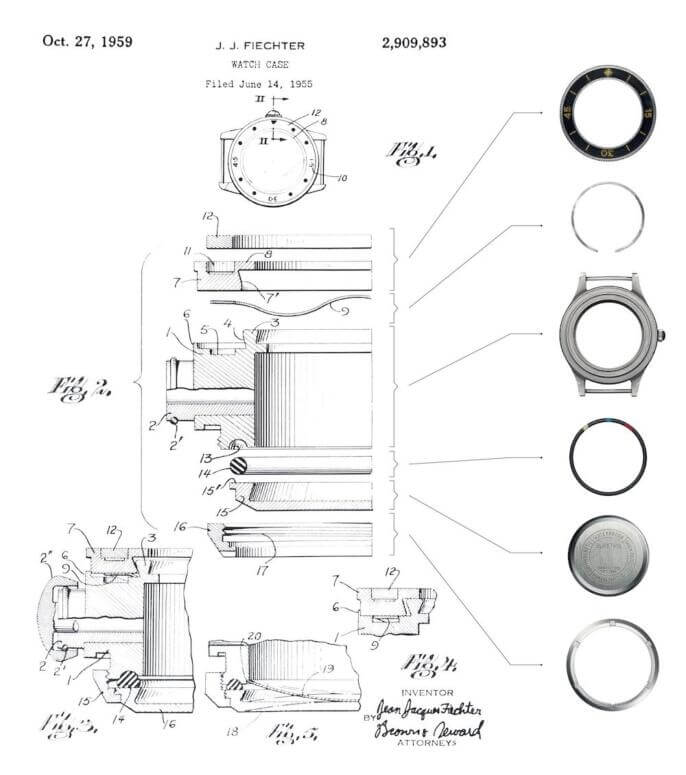
Beyond this, Jean-Jacques knew that the wristwatches of his time were simply too small for use underwater, where legibility is key. He worked on larger case sizes with his aunt Fiechter’s neighbour, who happened to be a casemaker; Jean-Jacques shared the same home as his aunt, who lived upstairs while he lived on the first floor.
On the same theme of legibility, Jean-Jacques decided on a colour scheme of white against black, and luminous hands, for visibility in the dark, which was actually not new at that time. Similarly, for the movement, Jean-Jacques knew it had to be automatic, to reduce the risk of wear and tear on the crown. The final bit came down to resisting magnetism, but this needs to wait, because while Jean-Jacques was firming up his vision, the second foundational part of the dive watch story was taking shape.
The French navy was looking for a dive watch, and the two men in charge of this were Captain Robert ‘Bob’ Maloubier and Claude Riffaud, both veterans of World War II. They were the ones who saw the need for a combat diving force, and the French navy left it to them to found what would become the French Forces Elite Diving Corp. When it came to the timing instruments, the late Maloubier liked to tell a story of meeting a French watch executive from Besancon, and being furnished with small watches that were touted as “marvels” of water-resistance; these all drowned. Rather than being discouraged though, Maloubier and Riffaud drew up sketches of what they thought a dive watch should be: waterproof, self-winding, anti-magnetic, and a dial that could be easily read either in murky water or at night. They found no takers on their bold designs though, with one watch executive telling them that “there is no future in diving watches.”
Obviously, Maloubier and Riffaud found their way to Jean-Jacques and Blancpain. Here is how Maloubier described the meeting: “Finally there was this small business, Blancpain, that agreed to supply a watch that we imagined with a black dial, large numbers, clear indexes in the form of triangles, circles and squares, as well as a rotating exterior bezel with markings matching the dial. We had hoped to be able to commence a dive and position the bezel so as to be able to read the time using the large minute hand. We wanted each of the markers to be as prominent as a pole star for a shepherd.” All parties wanted the same thing, except for the anti-magnetic requirement, which Blancpain solved with the introduction of the soft iron inner case to protect the movement from magnetic fields.
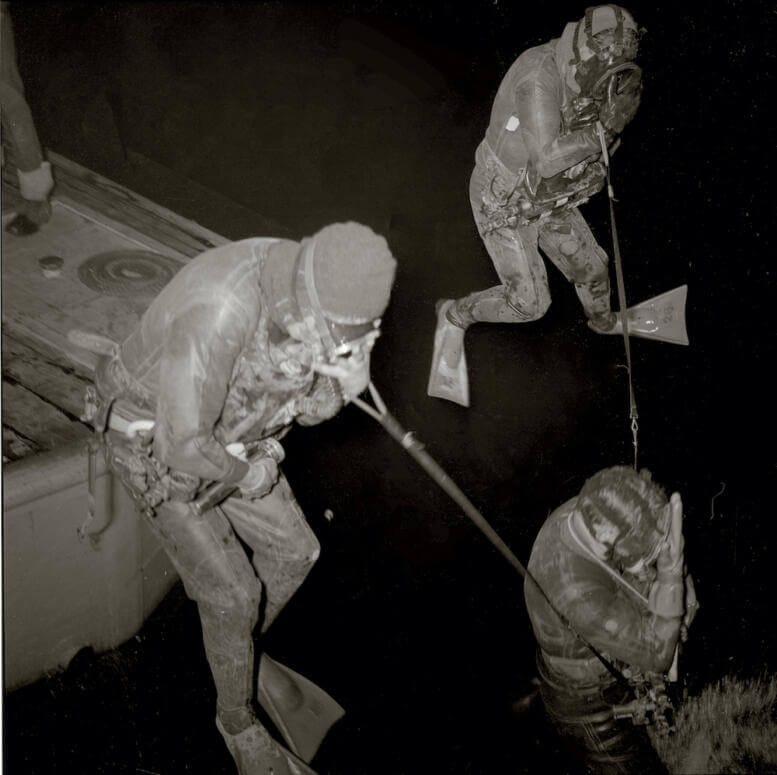
Here we race ahead a bit, because the next elements lead us to the present and possibly future of the Blancpain Fifty Fathoms watch. One year after the launch of the watch, in 1954, famed diver and marine biologist Jacques-Yves Cousteau selected the Fifty Fathoms model for his dive team, whose filmed dives became the basis of the Academy Award-winning film, “The Silent World” in 1957. Thus, the professional, recreational and conservationist characteristics of the Fifty Fathoms came together in just a few years. In terms of the world’s armed forces, the Fifty Fathoms quickly became the go-to option for the Israelis, West Germans, Danish, Norwegians, Swedish, Pakistanis and, most famously, the Americans, with the Navy SEALs.
The contemporary Fifty Fathoms that celebrates its 70th anniversary this year is no longer a tool watch used by the world’s navies, but it remains very much a part of the legend of the dive watch. It is also still a part of the conservation world, with Blancpain’s initiative called Ocean Commitment having raised both awareness of the need to protect the world’s oceans, as well as having a real impact in increasing the percentage of protected regions of the oceans by more than 20 per cent.
For the celebrations this year, you can see for yourself how Blancpain is leaning into this ocean conservation future in its advertising visual in the issue. It is also a very real part of the contemporary collection, being reflected in at least one of the 70th anniversary editions. But first, a tribute to the very first Blancpain Fifty Fathoms, and a totally new technical watch.
Fifty Fathoms Tech Gombessa
If the conservation angle is somewhat hidden in Act 1, it takes centre stage here, given that the name of the watch is the Fifty Fathoms Tech Gombessa, which is the 70th Anniversary Limited Edition Act 2. You may recall that Gombessa here is derived from Gombessa Expeditions, the initiative headed by marine biologist, photographer and diver Laurent Ballesta, and supported by Blancpain as a founding partner. The name is not there just to signify an important cause — the Tech Gombessa was jointly developed by Blancpain and Ballesta. The Tech part of the name is also pivotal, because it refers to the count-up bezel with three-hour display, which is totally new in a dive watch (or indeed any watch).
Unlike the Fifty Fathoms X Fathoms, the Tech Gombessa is not mind-bogglingly complicated. It is rather simple by way of comparison, but that is not the point. The original Fifty Fathoms was a watch designed to meet the needs of divers, and the Tech Gombessa follows the same narrative, except here, the heroes are Blancpain CEO Marc Hayek, himself an accomplished diver, and Ballesta. Ballesta wanted a watch that could serve him on closed-circuit rebreather diving excursions, and that is precisely what he got.
Now we do not have the space to get into what exactly CCR diving is, but suffice to say, the apparatus allows one to rebreathe the air one exhales. This means one can stay underwater longer, which is crucial for Ballesta’s work. How much longer? Well, there is where those three hours come into play. To make all this work, the Tech Gombessa features a helium escape valve (you know where it is), looking for all the world like a second crown, and a new movement, the automatic calibre 13P8, alongside the unidirectional bezel with three-hour scale. What looks like a GMT hand on the dial is in fact a hand that makes one circuit in three hours. It is meant to work in tandem with the 120-click bezel, about which we will say more when we discuss the case below.
You cannot really tell from looking at the watch here, without any reference or context, but this is a big boy, and it is significantly different to the vanilla reference 5015. The case is 47mm and 14.81mm thick, making it the biggest Fifty Fathoms reference since the X Fathoms. Blancpain has made the watch easier to wear though, with a case in grade 23 titanium and a lugless design. Yes, that means the black rubber strap (with extension) is fully integrated. The bezel has a good bit of overhang, making it easier to grasp, and the insert is executed in black ceramic rather than sapphire crystal, and slopes inward slightly. As a watch that is meant to be worn over a wet suit, the width and thickness are entirely fine, but you will need to consider how it sits on your wrist. Happily, you will have plenty of time to decide because the Tech Gombessa is not a limited edition — it joins the regular Fifty Fathoms collection. Needless to say, if CCR diving is your thing, this is just the right watch for you.
Finally, the dial is in a new shade of black called “absolute,” which apparently absorbs 97% of light that hits it. This has the effect of making the orange luminescent markers, which glow blue, really pop, as they say. The bezel markings and the three-hour hand glow green, by way of contrast.
Fifty Fathoms X Fathoms
A rare watch to experience in the metal, the Fifty Fathoms X Fathoms demonstrates just how far Blancpain goes — or should we say how deep. While other brands focus on so-called extreme dive models, Blancpain really leads the way with this 2011 titan of horology. A powerful reminder that the Fifty Fathoms was originally sold in dive equipment stores, the X Fathoms is like a dive computer, but in mechanical form. The watch is able to measure depths of up to 90 metres; store maximum depth achieved; has a separate indication on the 0-15m scale with exceptional precision of +/- 30cm; and has a retrograde 5-minute counter for decompression stops. That last one finally fulfilled Jean-Jacques Fiechter’s own conundrum in the fateful accident that eventually gave rise to the contemporary dive watch in the first place.
Fifty Fathoms 70th Anniversary Limited Edition Act 1
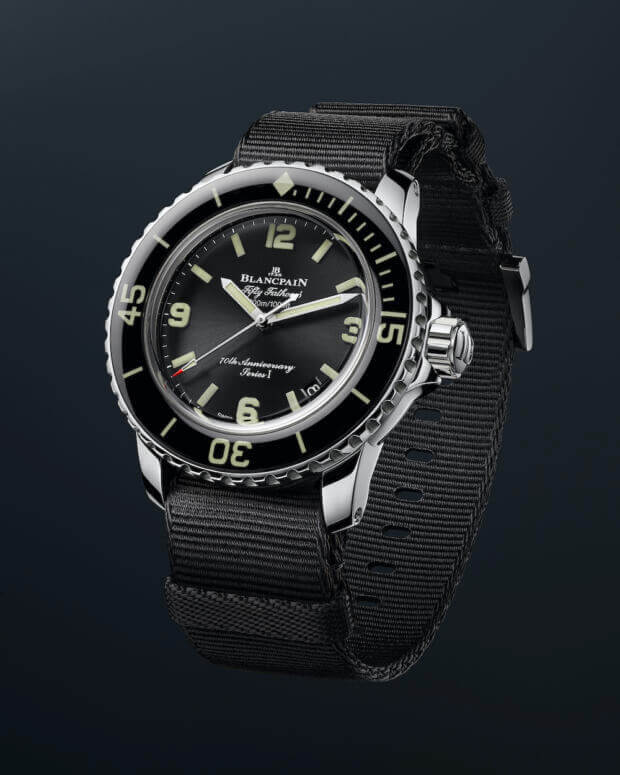
For the 70th anniversary of the Fifty Fathoms watch, Blancpain is pulling out all the stops, with a three-act plan, literally. Act 1 is a now-sold-out smaller version of the Fifty Fathoms, hewing closely to the original dimensions of the watch. We congratulate you if you managed to get one of the 70 pieces of Fifty Fathoms 70th Anniversary Limited Edition Act 1, to use its full name. To be clear, the 70 watches we are specifically referring to are the ones meant for the Asia-Pacific; there are two more limited editions of the same model in the same series, one for Europe, the Middle East and Africa, and one for the Americas. Still, 210 pieces seems but a drop in the ocean, considering that Act 1 is the most easily wearable Fifty Fathoms in years, clocking in at 42.3mm.
This is not a reissue though, by any means, because Act 1 retains some characteristics from the contemporary regular production model, including the engraved Blancpain logo on the left side of the case. It also nods towards the reintroduction of the Fifty Fathoms in 2003 with the stainless steel bezel with domed sapphire crystal inlay over luminous markings and a lozenge at 12 o’clock. The crown guards are also a feature introduced in the 2003 edition, and you will recognise other salient features from this seminal edition that brought the Fifty Fathoms into the 21st century. Water-resistance is, of course, 300 metres.
The dial is black, with brushed sunray finishing, so-called vintage hands (an evolution of the sword hands on the original), three-dimensional markers and Arabic numerals with cream-coloured SuperLuminova (the hands also sport the same luminous material). When it comes to the text on the dial, this is where you will find yourself a fan, or not. There are seven lines of text, including the JB 1735 logo, and the special 70th Anniversary words, with the series of the watch (I, II or III depending on region, as mentioned above) finishing matters off. Well, you might count the Swiss Made indication too, at 6 o’clock below and flanking the numeral. Like the contemporary Fifty Fathoms, the date window is between 4 and 5 o’clock (the so-called 4:30 position).
For the movement, this is also entirely contemporary, with the automatic calibre 1315 running the show, and showing off its three-barrel architecture via the sapphire exhibition window (itself an entirely contemporary touch). Calibre 1315 powers the current Fifty Fathoms reference 5015, so fans of the brand can expect no surprises there. Of course, the calibre does mark itself as something special, considering that the oscillating weight is in platinum, with “Fifty Fathoms 70th” engraved on it (platine is also happily engraved there). No special finishing has been applied here, which is appropriate considering that this is still very much a tool watch. One might go further here and say that the standard finishing on calibre 1315 is already exceptional for what it is, and beats most other dive watches out there.
Finishing things off here is an entirely contemporary touch that is in-line with contemporary concerns: the strap is of the black NATO variety, with pin buckle, but it is made from recycled fishing nets recovered from the sea. Considering the strong conservation message that Blancpain adopts and advocates, this is entirely appropriate.
For more watch reads, click here.





